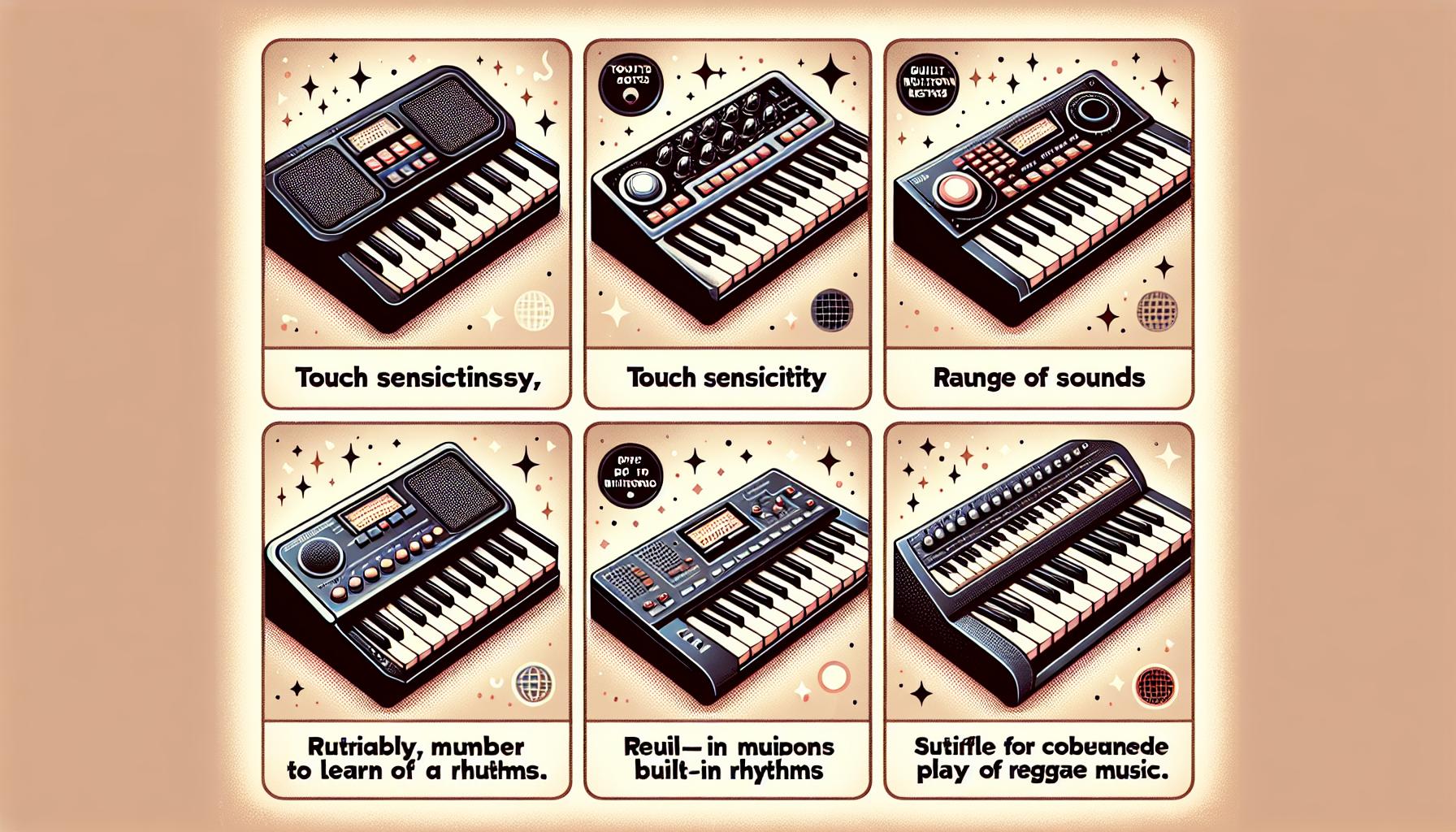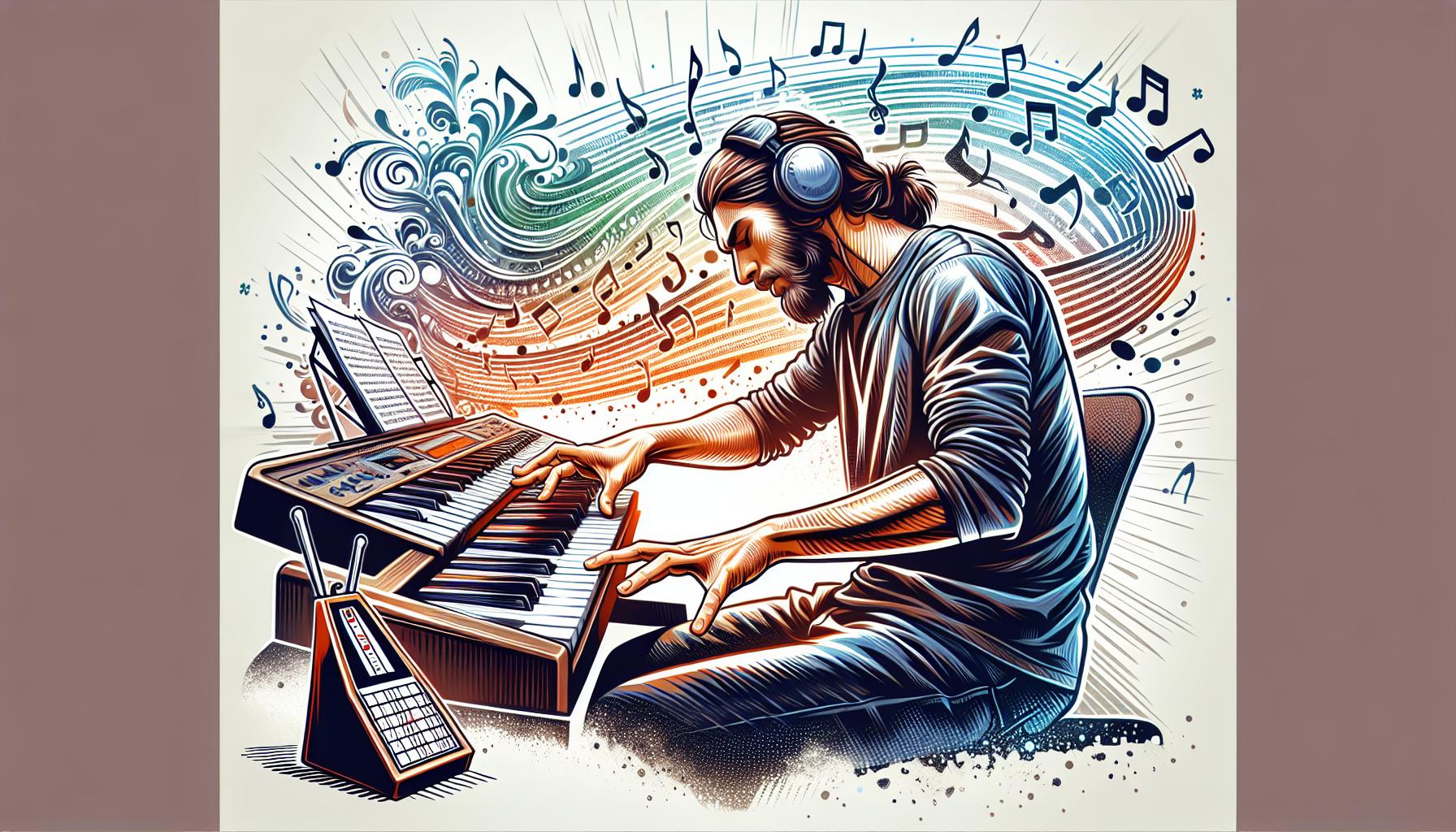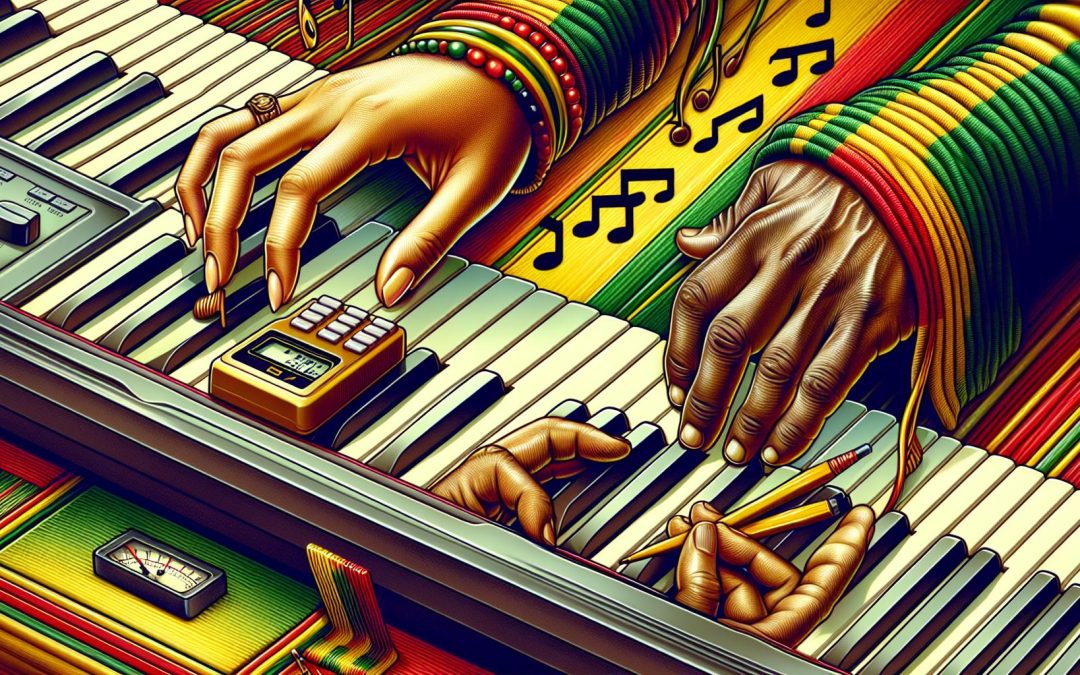Diving into the world of reggae music as a beginner keyboardist is like stepping into a vibrant, rhythm-filled realm. It's a genre that pulses with life, offering a unique blend of sounds and techniques that stand out from the crowd. For those just starting their musical journey, the reggae keyboard presents an exciting opportunity to explore new horizons.
Understanding the Basics of Reggae Music
Before diving into the technicalities of playing the reggae keyboard, it's essential to grasp the core elements that define reggae music. Originating from Jamaica in the late 1960s, reggae music is more than just a genre; it's a cultural movement with a distinctive rhythm and sound that has captivated audiences worldwide.
At the heart of reggae music lies its rhythmic complexity. Unlike many musical genres that follow a straightforward beat, reggae often plays around with offbeat rhythms, creating its signature "skank" sound. This unique rhythm is what gives reggae its laid-back yet compelling vibe, making it stand out from other genres.
Another key feature of reggae music is its bass lines. In reggae, the bass is not just background support; it's a lead instrument that drives the melody forward. These deep and melodic bass lines are crucial for setting the tone of a reggae piece, providing both rhythm and melody in a way that's distinctively regressive.
Chord Progressions in reggae music often adhere to a simpler structure, focusing on major and minor chords that evoke a warm, soulful feeling. This simplicity is part of reggae's charm, allowing the rhythm and melody to shine through without overly complex harmonies.
Integrating Reggae Elements into Keyboard Playing
When it comes to playing reggae on the keyboard, mastering the art of rhythm is paramount. Beginners should start by familiarizing themselves with the common offbeat patterns that define reggae music. Practicing these patterns can help build a solid foundation for more complex reggae rhythms.
- Practice offbeat rhythms
- Focus on simple major and minor chords
- Experiment with bass lines on the lower keys
Incorporating bass lines into keyboard playing can be challenging but rewarding. Beginners can start by playing along with their favorite reggae tracks, attempting to match the bass lines on the lower keys of the keyboard. This exercise not only improves timing and rhythm but also deepens one's understanding of reggae's melodic structure.
- Staccato: Playing notes in a short, detached manner adds to the rhythmic feel of reggae music.
- Syncopation: Emphasizing notes that are off the main beats of the
Choosing the Right Keyboard for Reggae Playing

When embarking on the reggae keyboard journey, selecting the ideal instrument is crucial. Beginners might wonder what makes a keyboard suitable for reggae as opposed to other genres. The truth is, while many keyboards can serve a wide range of musical styles, certain features make some models particularly adept for reggae's unique rhythm and sound.
Firstly, touch sensitivity is essential. This feature allows the volume and tone of a note to vary depending on how hard the keys are pressed, mimicking the dynamics of a real piano. Since reggae music relies heavily on expressive, soulful playing, having a touch-sensitive keyboard enables musicians to convey the genre's emotive depth more effectively.
Another key aspect is the range of sounds a keyboard offers. Reggae music often incorporates a variety of instrumental tones, such as organ, brass, and synth pads, aside from the classic piano sound. A keyboard that includes a broad selection of instrument voices can greatly enhance a reggae composition, providing the flexibility to experiment with different tones and textures.
Built-in rhythms also play a part. Many keyboards come with pre-programmed drum patterns and accompaniments. For beginners, practicing along with these rhythms can help them get a feel for reggae's syncopated beats and offbeat accents, vital components of its distinctive style.
Lastly, keyboard size and number of keys are practical considerations. Standard keyboards have 88 keys, but for reggae music, a 61-key keyboard can be sufficient. This size still offers enough range for bass lines, chords, and melodies, without the bulk or expense of a full-size model.
For a clearer understanding, here's a comparison of keyboards that are often recommended for beginners looking to play reggae:
| Feature | Keyboard A | Keyboard B | Keyboard C |
|---|---|---|---|
| Touch Sensitivity | Yes | No | Yes |
| Range of Sounds | 100+ | 50+ | 200+ |
| Built-in Rhythms | 50 | 20 | 100 |
| Number of Keys | 61 | 49 | 76 |
Learning Essential Reggae Chords and Progressions

After selecting the perfect keyboard for reggae, beginners must dive into the world of reggae chords and progressions to truly capture the genre's essence. Reggae music heavily relies on distinct chordal structures and rhythm patterns that are both unique and soulful. Understanding these fundamental aspects will significantly elevate a beginner's playing skills.
The Basics of Reggae Chords
Reggae typically revolves around a few key chords, making it accessible for beginners. The I-V-vi-IV chord progression is a classic in reggae music, creating a smooth, groovy feel that's unmistakable. This progression involves playing the first (I), fifth (V), minor sixth (vi), and fourth (IV) chords of any given key. For example, in the key of C major, these chords would be C, G, Am, and F respectively.
Moreover, mastering the art of minor chords and their transitions is crucial. Reggae often employs minor chords to evoke a deep, emotional resonance. Beginners should also pay attention to the off-beat or 'skank' rhythm, where chords are played on the off-beats or the "and" of each beat. This is a hallmark of reggae music and is essential for creating that signature reggae sound.
Progressions to Practice
To get started, here are some simple yet popular reggae chord progressions that beginners can practice:
- I-V-vi-IV: As mentioned, this progression is a staple in reggae music. Experimenting with different keys can help in mastering it.
- ii-V-I: This is another common progression, providing a slightly more jazzy feel. It's great for songs that lean towards reggae fusion genres.
- vi-IV-I-V: This progression gives a more emotional tone and is perfect for romantic or slower reggae tunes.
Practicing these progressions helps in developing a good ear for reggae music and enhances the ability to create or improvise songs.
- Use a Metronome: Playing along with a metronome will help in getting comfortable with the reggae rhythm, especially the off-beat skank.
- Listen and Play Along: There’s no better way to learn than by listening to classic and modern reggae hits and trying to play along. This allows beginners to get a feel for how chords
Mastering Reggae Keyboard Techniques

As beginners venture into the world of reggae keyboard playing, mastering specific techniques becomes paramount to truly capturing the essence of reggae music. One of the key aspects to focus on is the staccato playing style. This involves playing the chords in a quick, detached manner which allows for the rhythmic patterns unique to reggae to shine through. Often, beginners might find this challenging, but practice leads to perfection. Incorporating exercises that emphasize wrist flexibility and control can greatly improve staccato playing.
Another technique that holds significant importance is the use of off-beats or syncopation. Reggae music characteristically emphasizes the “and” counts between beats, creating its distinctive laid-back feel. Keyboard players can achieve this by practicing playing chords and melodies off the main beats. Starting slowly with a metronome and gradually increasing the speed ensures that the timing becomes second nature.
Incorporating bass lines into keyboard playing also offers a fuller sound and a deeper connection to reggae’s roots. Most reggae songs feature prominent bass lines that drive the rhythm. Keyboard players can mimic these lines in their lower octaves or even split their keyboard if the option is available. Playing bass lines requires not only a good ear but also an understanding of reggae's rhythm and structure. Listening to and playing along with reggae classics can help players develop this skill.
Articulation plays a crucial role in reggae keyboard techniques. Articulating chords and notes in a way that they resonate with reggae’s unique vibe involves precise control over pressure and timing. Beginners should focus on how hard they press the keys and how that affects the sound. Experimenting with different pressures and timings can lead to a more authentic reggae sound.
Dynamics in reggae music often fluctuate within a song, reflecting its emotional landscape. Keyboard players need to master controlling dynamics to effectively contribute to the overall mood of the piece. This involves selectively emphasizing certain chords or notes and can be practiced by playing along with dynamic shifts in reggae songs.
Finally, improvisation plays a vital role in reggae keyboard playing. While reggae has its foundational chord progressions and rhythms, the magic often happens in spontaneous moments. Encouraging keyboard players to improvise, whether over a basic chord progression or along with a track, fosters creativity and a deeper understanding of reggae’s essence. This requires a balance of technique, theory, and most importantly, feeling the music.
Putting It All Together: Practicing and Creating Your Own Reggae Music

Once the fundamentals of reggae keyboard techniques are grasped, the next step is weaving these elements into a cohesive musical piece. Practicing consistently is the cornerstone of this journey. Creating reggae music that resonates requires not only technical skills but also a deep understanding of the genre's soulful and rhythmic essence.
They should start by dedicating time to practice each technique separately. Combining staccato playing, mastery of off-beats, and the emulation of bass lines forms the foundational sound of reggae music on the keyboard. Incorporating wrist flexibility exercises and metronome practice into daily routines dramatically improves rhythm and timing, essential for authentic reggae sound.
After gaining comfort with individual techniques, the next step is to blend them. Start with simple chord progressions and experiment with adding off-beats and bass lines. Here are some practical steps to follow:
- Warm up with basic scales and chords to prepare the fingers for more complex movements.
- Practice each technique individually before attempting to combine them.
- Use a metronome to keep steady timing, gradually increasing complexity.
- Record practices to identify areas for improvement and track progress.
Reggae music thrives on improvisation and emotional expression. They should not shy away from experimenting with different rhythms, pressures, and timings. This not only enhances their playing style but also deepens their appreciation for reggae music's diverse and rich culture. Listening to a wide range of reggae artists and songs can provide inspiration and a better understanding of how to craft unique sounds and rhythms.
Exploring the creative process of songwriting is another exciting step in creating reggae music. They can start by:
- Writing simple melodies and building around them with reggae rhythms and techniques.
- Incorporating different keyboard sounds to explore varied sonic textures.
- Collaborating with other musicians to learn from their experiences and integrate new ideas.
The path to mastering reggae on the keyboard is both challenging and rewarding. With dedication to practice, a love for the genre, and a willingness to experiment, they can start producing their own reggae music, imbued with their unique artistic touch. Engaging in online communities or local workshops provides additional opportunities to share music, receive feedback, and continue growing as a musician.
Conclusion
Embarking on the journey of playing reggae keyboard opens up a world of musical exploration and creativity. With dedication to practice and a deep dive into the rhythms that make reggae so unique, beginners will find themselves growing not just in skill but also in their appreciation for this soul-stirring genre. Remember, the path to mastering reggae on the keyboard is as much about feeling the music as it is about the techniques. So keep experimenting, stay connected with fellow musicians, and let your love for reggae guide your progress. There's a whole world of reggae music waiting for your personal touch.
Harlan Kilstein began playing piano during covid with no piano background at all. He taught himself how to play learning what to do and what not to do.
Today he's an advanced intermediate player and can help you grow in your skills because he learned all this on his own.








